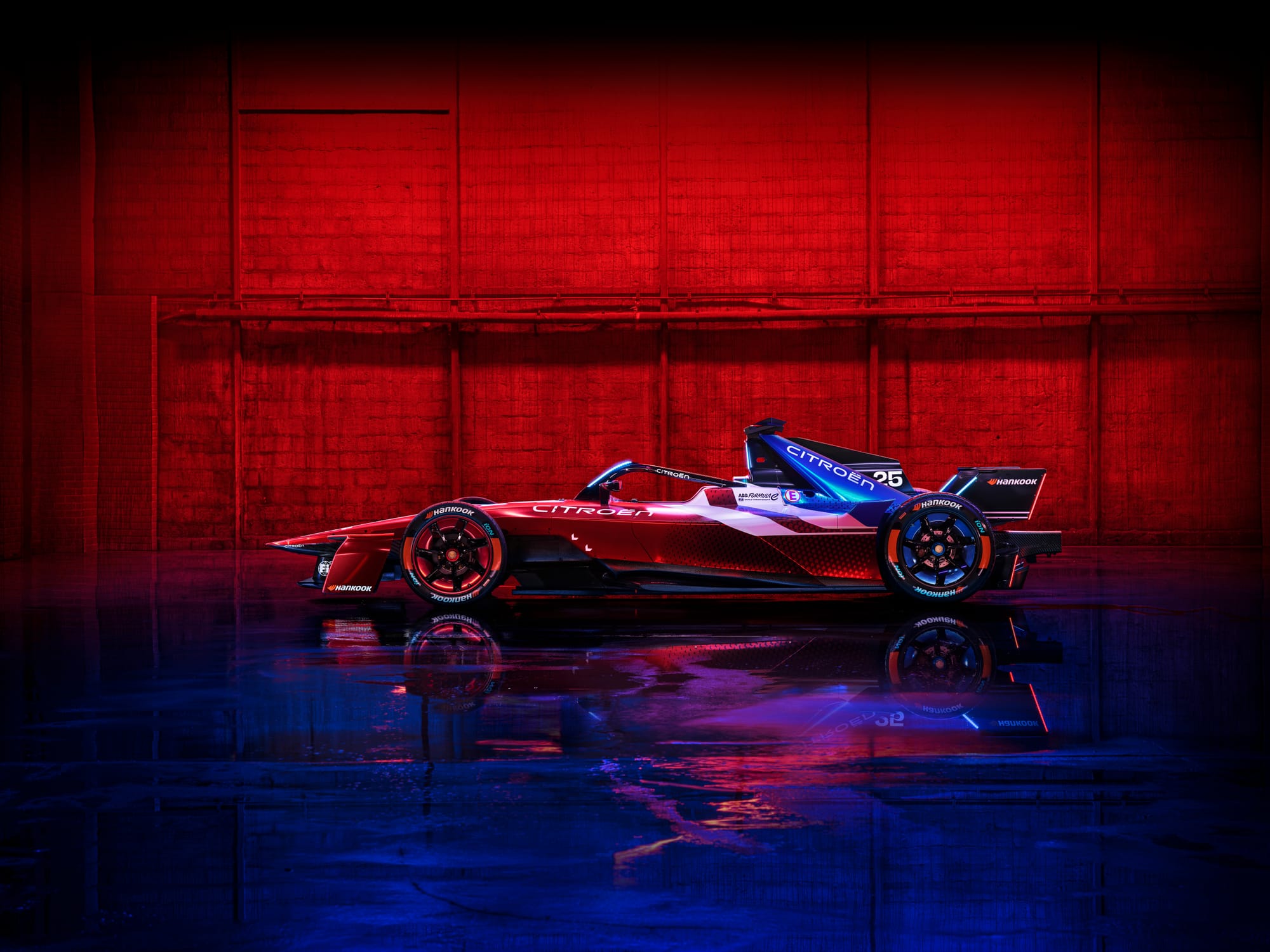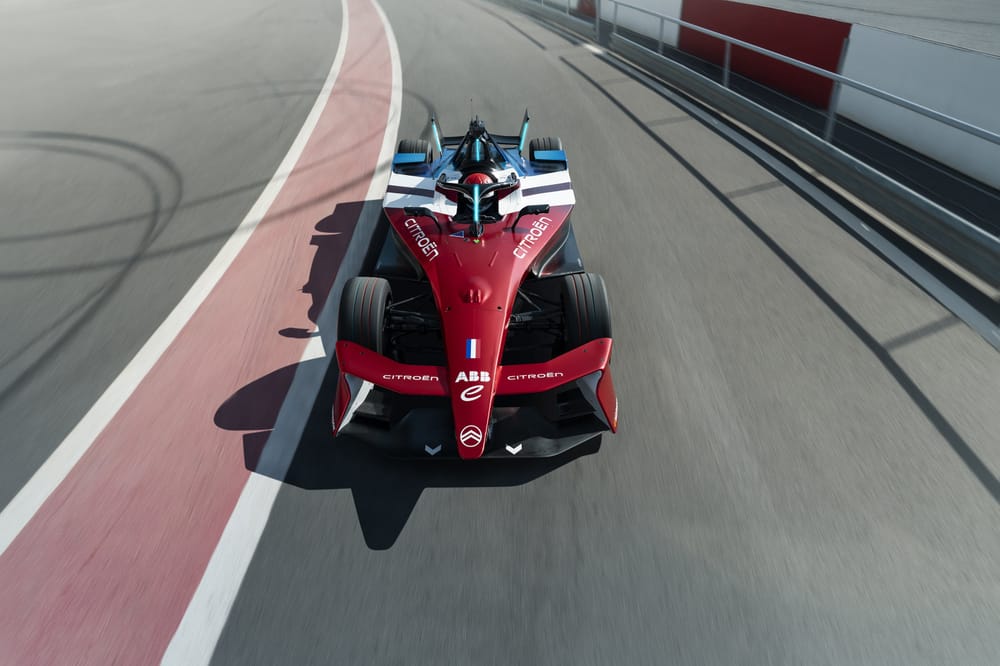Citroen is officially back in the top level of international motorsport for the first time since it ended its once-dominant World Rally Championship programme at the end of the 2019 season.
Its new Formula E project will be the first time Citroen has branched out into global single-seater competition.
This week there was no shortage of ambition and optimism flowing down glitzy Champs-Elysees, where the programme was launched and adorned by a patriotic red, white and blue tricolore livery.
But the whys and hows of the Stellantis owned brand coming to Formula E both underpin and amplify why Stellantis has stayed true to its commitment to FE. There's a fascinating background to a change that goes far beyond stickers and liveries.
How and why Citroen got to Formula E
Citroen became part of Stellantis when the PSA Group (that primarily included Citroen and Peugeot) merged the Fiat Chrysler Group - a deal that was completed in early 2021 - and has felt like a brand ripe for a new injection of sporting endeavour via a big race programme for several years.
With Peugeot having a magnetic attraction to endurance racing in its DNA, Citroen - along with Opel, which may also join Formula E shortly – was the most obvious choice among Stellantis brands to replace Maserati on the Formula E grid.
But what should have been a simple affair of straight brand replacement became complicated by several factors, some within and some outside of Stellantis' control.
Notable was the model Stellantis used for Formula E, which was of partnering with an operational and licence owning entity – Penske for DS and MSG for Maserati (now Citroen). That gave it only a certain amount of power in the ultimate decision making process.
Irrespective of that, Stellantis through its agility in its multiple brand options, is undoubtedly a huge asset for Formula E. But the ownership misadventures of the MSG team over the last couple of years made it a fragile partner. MSG had accrued significant debt and was up for sale, via being in the custodianship of the promoter Formula E Operations itself.
Earlier this year, the outgoing McLaren entity was close to securing a deal with Stellantis to clutch a last gasp deal to continue in Formula E. The intricacies of why it didn't happen won't be divulged by those close to it but the assumption is that the state of MSG and its need for survival because of its debt situation usurped the essentially second in line McLaren.
Citroen Racing does not actually own the licence entry for the team that bears its name. The Race understands that several parties are showing serious interest in acquiring the MSG licence right now, and new ownership could be confirmed prior to the start of the coming 2025-26 season in early December.
CEO of Citroen, Xavier Chardon, joined from Volkswagen in June but oversaw the formal superseding of Citroen with Maserati in Formula E.
"We explored almost all the areas [of motorsport] and the fact that it's electric, the fact that it's also going into city centres, it's very, very important," he explained to The Race.
"It's also the perfect test bench for our electrification programmes, especially software management and all those elements. It's very, very important for us."

Stellantis Motorsport vice president Jean-Marc Finot and FE programme director Leo Thomas are the driving forces at Stellantis Motorsport and manage the overall programme technically and politically.
Finot has been adamant that the flexibility of the brand range in Stellantis is a key strategic asset when it comes to Formula E. But for the new era of Gen4 the model that it will use is, like its brand flexibility, potentially accommodating.
That could mean that another brand, such as Opel, comes in for Gen 4 via an ownership of an entry slot, although it's not known yet if this is close to being a done deal.
"We work as one team like we used to do with Techeetah years ago," Finot told The Race.
"We think that we can improve our efficiency by working as one team."
That alludes to more overall technical control via Satory, Stellantis Motorsport's base and ironically the nerve-centre that was initially built to manage and run the famed Citroen WRC projects of years gone by.
MSG's Monaco base still has operational and admin value but possibly not for too much longer. Some continuity has been set by Cyril Blais remaining as team principal, something that in light of his efforts to keep Maserati MSG anything approaching sane last season in the face of myriad challenges, is a compelling and rock-solid call indeed.
DS Penske meanwhile is soon to enter its final season as a partnership, with Penske still forming what its Gen4 package will be. For DS Automobiles a wind-down of its Formula E efforts is probable, possibly to be replaced by Opel, although the exact structure of this is still believed to still be under review.
Opel executives were in Monaco in May and despite some significant intra-business politics, have taken some interest in placing the brand in Formula E.
That clearly is endorsed by Formula E's head honchos, among them CEO Jeff Dodds.
From Formula E's vantage point, the shuffling of brands is really something of a bonus, one that rarely happens so freely with the likes of for example Volkswagen or BMW in motorsport.
"The beauty of Stellantis is that if a second brand is coming in, and if it were Opel, then clearly they will announce for Gen4," Dodds told The Race.
"If they're going to announce another brand in the championship, and let's hope they are, I think they'll wait until we're closer to the first reveal of the Gen4 car [next spring] before they do that.
"Having someone like Stellantis, that can get scale economies out of leveraging the investment across their brands is a really good thing.
"I think for our championship, they're a recognisable household brand, which is great. They've got incredible engineering discipline down in Satory, and we love having them because they're a massive, global car company."
The Cassidy/Vergne dynamic
Has Citroen secured one of Formula E's most dynamic driver duos or a combustible catastrophe waiting to happen?
On face value Nick Cassidy and Jean-Eric Vergne is in anyone's perception surely one of the strongest partnerships ever seen in the championship. But there have been warnings before that it could be a combination that won't take much to get rather lively.
Misano, April 2024. Cassidy has had a bruising weekend in his Jaguar already. Put on the backfoot by a shunt while coming across Sam Bird's slowing McLaren in practice (a shunt that woke up The Race's correspondent stood within feet of the impact point), Cassidy then made up for lost time and was in contention in one of Formula E's most barmy pack-races. It was exactly the kind of madhouse that Cassidy's genius 12-steps-ahead process thrives in.
Then contact with Vergne's DS Penske at the ludicrously tight and quick back chicane. He was out and he was angry and he wasn't afraid to show it externally or on the pit to car radio either.
There was a short period of intense cool between the two but a forthright conversation shortly after put it all to bed.
In a way it is surprising that this has been the only real noticeable spat between two of Formula E's more alpha characters behind the scenes and on track. But that doesn't mean to say flashpoints are inevitable.
Each is experienced enough now to give and take, and indeed each of them has done so with a variety of team-mates in the past – Cassidy with Sebastien Buemi and Mitch Evans, Vergne with Antonio Felix da Costa and Maximilian Guenther especially.
Wasting energy on intra-team politics and shadow boxing team-mates pointlessly is something that each driver is mature enough to not compromise both their own personal efforts, or that of their new-look team, with - certainly in the very first season.



